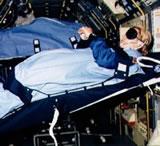 Could astronauts really sleep for 6 months at a time?© NASA
Could astronauts really sleep for 6 months at a time?© NASAThe state of suspended animation that astronauts enter during long-haul space flights is a staple of science-fiction movies. But now the European Space Agency (ESA) wants to turn it into reality.
Agency staff are planning future research into the possibility of inducing a hibernation-like state in humans. "We are not sure whether it is possible," says Marco Biggiogera, an expert on hibernation mechanisms at the University of Pavia, Italy, who is advising ESA. "But it's not crazy."
“We're not sure whether human hibernation is possible. But it's not crazy”
Marco Biggiogera
Hibernation researcher at the University of Pavia
ESA believes hibernation would help astronauts to cope with the psychological demands of decades-long return journeys to destinations such as Saturn. And because less space and food would be needed on such missions, the spacecraft would be lighter and easier to launch.
Practical hibernation mechanisms are at least a decade away, says Mark Ayre of ESA's Advanced Concepts Scheme. But he and colleagues are already considering what research needs to done to bring such systems to reality.
One route of inquiry centres on DADLE (D-Ala,D-Leu-enkephalin), a substance with opium-like properties. An injection of DADLE is known to trigger hibernation in ground squirrels during the summer season, when the animals would normally be awake. It also seems to send cultures of human cells to sleep: the cells divide more slowly and their gene activity drops when the molecule is applied, say Biggiogera and his colleagues in the European Journal of Clinical Investigation1
 Researchers are already trying to get rats to hibernate.© 2000-2004 Martin Krzywinski
Researchers are already trying to get rats to hibernate.© 2000-2004 Martin KrzywinskiResearchers want to test DADLE in non-hibernating animals, starting with rats. Carlo Zancanaro and colleagues at the University of Verona, Italy, ran such an experiment last month and are currently analysing data from sensors that tracked the animals' heartbeats and brain activity after DADLE was applied.
Muscle booster
Researchers are following up other leads too. One downside of hibernation is that it leads to loss of muscle strength, a problem that also afflicts patients confined to bed after an operation. Zancanaro points out that such bedridden patients retain more strength if they receive dobutamine, a drug used to boost the strength of heart muscles2, so a similar treatment might work during hibernation.
Biggiogera would also like to study the Madagascan fat-tailed dwarf lemur (Cheirogaleus medius), revealed this year in Nature as the first primate known to hibernate3.
The plan, which should be completed in around a year's time, will spell out how such studies could be developed in order to investigate human hibernation. As that unfolds, Ayre will analyse the engineering side of the challenge. ESA wants to send a human mission to Mars in 2030, so he and colleagues are drawing up paper plans for integrating a hibernation system into the craft. The exercise should show how much energy and space could be saved.
Hibernation researcher at the University of Pavia
-
References
- Vecchio L., Baldelli B., Malatesta M.& Biggiogera M. European Journal of Clinical Investigation, 33. (suppl.) 49 (2003).
- Sullivan M. J., et al. Clin. Invest., 76. 1632 - 1642 (1985). | ChemPort |
- Dausmann K. H., Glos J., Ganzhorn J. U & Heldmaier G, et al. Nature, 429. 825 - 826 (2004). | Article | PubMed | ISI | ChemPort |
